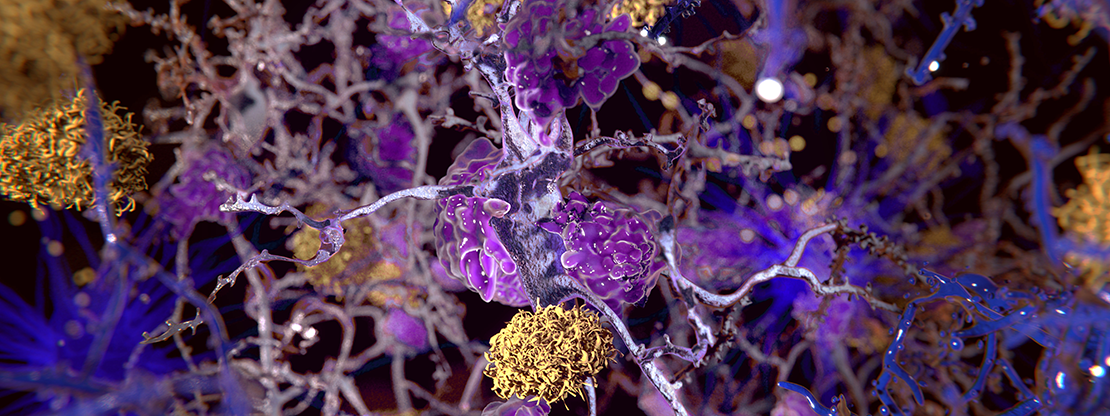Alzheimer’s disease is the most common cause of dementia worldwide. It was first recognized under its current moniker in the early 1900s, but it was not until the early 1990s that scientists established the first clear links between the disease’s onset and genetics.
That breakthrough came after researchers isolated a protein encoded by our DNA that, when mutated, can give rise to harmful plaques in the brain. The discovery sparked a period of great strides in our understanding of Alzheimer’s, with researchers going on to identify several other genetic contributors to the disease.
In the decades since those groundbreaking findings, and despite numerous other discoveries in the field, there still are no treatments to slow or stop progression of Alzheimer’s. Now, two Van Andel Institute scientists believe they can strengthen our understanding of the disease’s genetic precursors and find avenues for potential new therapies by hunting for clues in one particular group with a unique genetic makeup: the Portuguese population.
Why Portugal?

Rita Guerreiro, Ph.D., and José Brás, Ph.D., are associate professors in the Institute’s Center for Neurodegenerative Science. Guerreiro and Brás joined the Institute in 2018 from University College London; both are originally from Portugal, and both are experts in genetic contributions to neurodegenerative diseases like Alzheimer’s, Parkinson’s disease and Lewy body dementia.
In spring 2020, Guerreiro was awarded a five-year, $3.7 million grant from the National Institute of Aging of the National Institutes of Health to study the genetic predisposition to Alzheimer’s in the Portuguese population. It will be the largest and first study of its kind in the country.
The Portuguese population may hold clues that could enhance our understanding of the disease’s genetic origins for several key reasons:
- Unique genetic profile: The genetic profile of the Portuguese population is homogeneous and predominately European but retains contributions from North and Sub-Saharan African and Sephardic Jewish populations. This diverse genetic makeup may hold promising insights into the disease, its onset and its progression.
- Evidence of hereditary Alzheimer’s: There is a high number of early onset Alzheimer’s cases in the Portuguese population, and a high incidence of families with multiple generations affected by the disease, despite an overall low frequency of mutations associated with it.
- Risk factors: Preliminary studies by Guerreiro and Brás indicate the amount of risk variants in the Portuguese population differs from other populations.
In all, the study hopes to evaluate 25 families, 2,500 sporadic Alzheimer’s cases and 2,500 controls in the course of their research.

“Existing data about the familial incidence of Alzheimer’s in Portugal has helped us glean some details about the disease’s possible biological contributors in the country,” Guerreiro said, “but there are many questions waiting to be answered.”
What’s next?
Guerreiro and Brás first became interested in studying the genetic predisposition to Alzheimer’s disease in the Portuguese population while working on their master’s degrees in 2004. Over the years, they have informally studied the disease’s prevalence in the country. The grant will support formalizing and systematizing the research.
The researchers will identify common and rare genetic risk variants associated by mapping and analyzing the genome of a Portuguese sample population. This data will be combined with publicly available genomic data from non-Portuguese populations to increase the diversity and statistical power of ongoing international studies.
Samples will be gathered with the help of scientists and researchers in Portugal, with whom Guerreiro and Brás have collaborated for more than a decade. The genetic samples will be sent to the Institute, where they will be analyzed.
Why does it matter?
This line of research has strong potential to significantly add to our understanding of the genetic and biological pathways that Alzheimer’s uses to take hold in the body. The findings could pinpoint new biomarkers and identify genes that can be used in model systems to help guide scientists in the development of new treatments for the disease.
“This line of inquiry is many years in the making for us,” Brás said. “We are very thankful to have funding support, as well as our excellent collaborators in Portugal, as we search for more clues to produce better outcomes for people affected by Alzheimer’s.”
Research reported in this publication is supported by the National Institute on Aging of the National Institutes of Health under award no. R01AG067426 (Guerreiro). The content is solely the responsibility of the authors and does not necessarily represent the official views of the National Institutes of Health.

